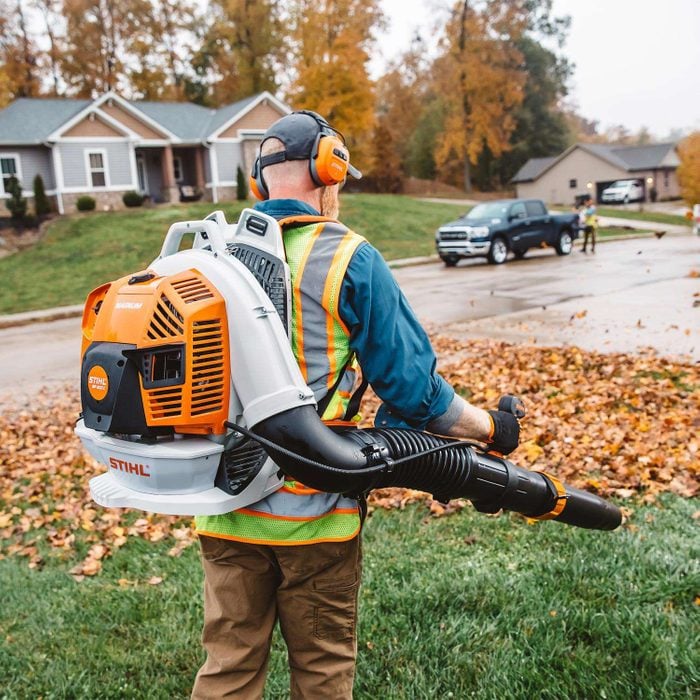VIA MERCHANT
VIA MERCHANT
Pros:
-
Hassle-free electric start
-
642 CFM and 221 MPH
-
Adjustable tube length and control handle position
-
Anti-vibration system
For those who find themselves dealing with a lot of leaves and aren’t afraid to shell out for the best gas leaf blower, you’ll want to take a look at the Stihl gas backpack blower with electric start. With a quick electric start, there’s no idling while walking across the yard to the next cleanup area or removing the unit to restart. Plus, it has powerful blowing power (642 CFM and 221 MPH) and a large fuel tank. All of this machine’s controls are on one handle, making it easy to operate.
Types of Gas Leaf Blowers
- Handheld leaf blowers: The most common choice, suited for smaller lawns and available in gas, electric and corded models. A big perk is portability.
- Backpack leaf blowers: These have straps to wear on your back. They’re a smart option for an acre-plus of land. Available in gas and electric models.
- Wheeled/Walk-behind leaf blowers: These are more specialized, often commercial models, ideal for large flat yards and heavy-duty tasks.
What to Look for When Buying a Gas Leaf Blower
With so many options, narrowing down the best leaf blower can be tricky. Consider noise levels, maintenance and price, but we consulted 20 gardening experts to determine what they prioritize in a gas leaf blower.
Power and Engine Type
- Two-stroke vs. four-stroke: The main difference is size and power. A two-stroke engine is smaller and lighter, while a four-stroke offers more power but is bigger and heavier. A two-stroke is fuel-efficient and suitable for small jobs, while a four-stroke may be better for larger areas.
- Engine Size (cc): Engine size is measured in cubic centimeters (cc). Ratings can range from around 50cc to nearly 100cc. Higher numbers usually mean larger engines, but power also depends on whether it’s a two- or four-stroke engine.
Air Volume (CFM) and Air Speed (MPH)
- CFM vs. MPH: CFM vs. MPH: CFM (cubic feet per minute) measures how much material the blower can move, while MPH (miles per hour) measures the speed at which air exits the nozzle.
- CFM: “CFM is a measurement of how much material a leaf blower can move. The higher the CFM, the more material it can move,” explains Sarah Jameson, gardening expert and founder of Lawn Chick. Around 300 CFM is good for basic tasks, while over 500 CFM is best for heavy-duty work.
- MPH: “MPH measures the speed at which air is pushed through the blower’s nozzle and is directly related to the speed at which you can clear leaves from your yard,” Jameson continues. MPH typically ranges from 150 to 250, with higher speeds that are better for large yards.
Weight and Ergonomics
“Look for features like adjustable tube lengths, soft-grip handles and a balanced design,” says Aaron Green, owner of Essential Home & Garden. “Your back will thank you.”
Also, consider a weight you can comfortably hold for long periods. While weight is important, consider whether your leaf blower has a harness or shoulder strap. Harnesses provide more security and comfort for carrying the weight, but they can be slower to put on and more restrictive. Straps, while convenient and quick, offer less comfort and stability but are easy to unsling and set down when needed.
Leaf blowers often vibrate due to the fan inside, leading to discomfort over time and may require breaks. Excessive vibration could indicate a damaged fan blade, and if that happens, stop using the blower and get it checked for maintenance.
Noise Level
Leaf blowers are noisy. A standard conversation is about 60 decibels, while most blowers average 70-75 dB from 50 feet away. Always wear ear protection rated for your blower’s noise level. If it gets louder than usual, something may be wrong, so stop and check for issues.
Starting Mechanism
“Check if the blower features a reliable and user-friendly starting mechanism, such as a primer bulb or a choke,” says horticulturist and landscape designer Jack Hall. “Quick and hassle-free starting can save time and frustration.”
- Easy-start buttons are now widely available, simplifying the startup process.
- Auto-choke mechanisms, which reduce air intake and allow a fuel-rich charge into the engine, are also increasingly common.
Fuel Efficiency and Emissions
“Look for models with adjustable throttle settings to match the power output to the task at hand,” Hall says.
Remember that a larger adjustable leaf blower, like a four-stroke, may consume more fuel than a smaller two-stroke. The fuel tank size will impact how long you can operate the leaf blower between refills—larger tanks tend to burn fuel more quickly. On average, you can expect about three hours of use per half-gallon of gas, though this varies with usage intensity. Always check EPA and local government regulations (such as California’s CARB) to ensure your leaf blower complies with emissions standards.
Yard/Job Size
Match the blower’s power to your yard size. A smaller two-stroke works fine for small to medium yards, while a four-stroke is better for bigger areas or professional use.
Maintenance and Durability
Check the maintenance schedule before buying. Some blowers require more upkeep than others. Stick to the schedule and consider having a professional handle it if needed. Also, review the warranty to know what’s covered and what voids it.
Additional Features
Some extras can make a difference, like cruise control for consistent power output without holding the trigger or various nozzle attachments for different tasks. Variable speed control is another useful feature, although not all blowers have it.
Why You Should Trust Us
We have personally tested dozens, if not hundreds, of leaf blowers, including backpack, corded electric, cordless and gas-powered handheld models. If it blows air, we’ve likely used it and put it through its paces.
Tyler Graham, a former landscaper with years of daily experience using lawn tools, has developed a deep passion for them—especially leaf blowers. Now a self-professed leaf-blower enthusiast, Tyler tests lawnmowers, string trimmers and leaf blowers. He played a key role in selecting this list, personally testing each product. He also runs The Lawn Review. Family Handyman Shopping Editor Mary Henn also researched and tested products to help select the best leaf blowers.
Beyond our own testing and research, we consulted experts like Zahid Adnan of the Plant Bible (chief editor and gardening expert), professional landscaper Ralph Joed Abundo, Lawn Chick founder Sarah Jameson, Aaron Green of Essential Home & Garden, horticulturist and landscape designer Jack Hall, GreenPal founder Gene Gaballero and Kris Kiser, President & CEO of the Outdoor Power Equipment Institute (OPEI). Their collective knowledge represents decades of experience in gardening and landscaping with extensive use of leaf blowers.
Sean Tirman, Content Updates Editor at Family Handyman, updated and contributed research to this piece. Sean has written shopping guides since 2016 and is a former associate editor at Gear Patrol and HiConsumption.
How We Tested the Best Gas Leaf Blowers
We tested over 15 gas leaf blowers, evaluating them based on industry standards like air volume (CFM) and airspeed (MPH) and real-world factors such as ergonomics, noise level and ease of use. Our tests spanned a variety of tasks, from small yard cleanups to heavy-duty jobs, with some units running for over 30 hours to assess long-term reliability. We consulted expert reviews and customer feedback for models we didn’t test directly. We focused on key features like engine power, fuel efficiency, ease of starting and overall performance, ensuring a well-rounded evaluation for homeowners and professionals alike.
FAQ
Is it better to have more mph or CFM in a leaf blower?
For moving large amounts of material or dealing with wet leaves, aim for higher CFM. Homeowners with bigger yards should prioritize higher MPH to finish the job faster. For small yards, a gas leaf blower with at least 200-400 CFM is sufficient, while a mid-sized yard with more leaves should have 400-700 CFM.
Are gas leaf blowers more powerful than electric ones?
Generally, gas leaf blowers are more powerful than electric ones, but the power can vary by brand and model.
What are the pros and cons of gas leaf blowers?
Gas leaf blowers are known for their reliability, longer run-time, power and durability. However, they are loud, emit gas odors and require yearly maintenance.
What is the most reliable leaf blower brand?
After consulting over 20 gardening experts, Husqvarna emerged as the most reliable leaf blower brand.






























